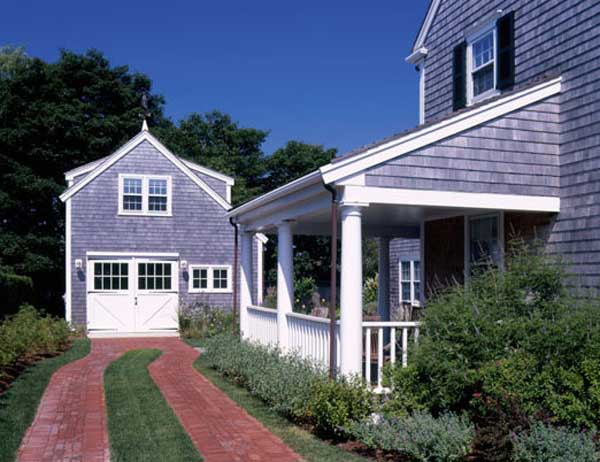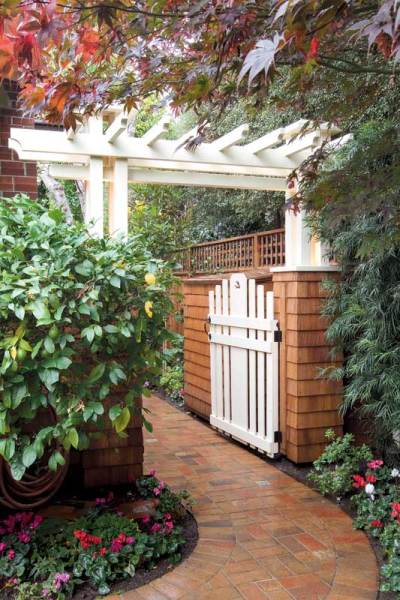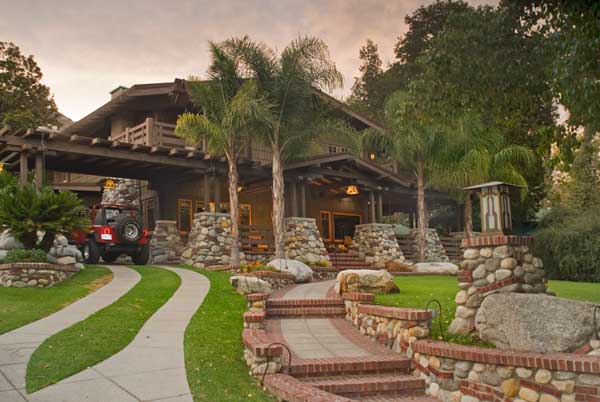
A classic double-track driveway runs to the detached garage; brick and weathered cedar shingles are ubiquitous on Nantucket. (Photo: Peter Zimmerman Architects)
Given the modern fondness for multi-car garages and SUVs, adding a drive or walkway to a historic property can be a bit tricky. Take a good look at your house: consider its age, style, and the materials used to build it. For their walkways and driveways, what would earlier owners have chosen if they’d had today’s perspective and materials?
For Early American Houses
Then: Most houses built before 1850 were reached via ephemeral dirt paths. Look for the most likely approach, and you may find evidence of an original track. These paths were direct rather than meandering, and not very wide, perhaps 3′ at most. Where they existed, drives were no more than 12′ or so wide. Approaches to grander homes were stabilized with readily available materials, like fireplace or stove cinders mixed with mud or clay, or sand.
Now: Cinders are hard to come by, and oyster shell is an environmental no-no thanks to depletion of natural oyster beds. But modern concrete is the descendant of historic ash-and-clay blends. Period-friendly solutions include gravel, brick, stone, and substitute pavers that look like brick or stone. You might consider a double
track of brick or concrete (for an “installed in the 1920s” effect). For greatest authenticity, keep the drive narrow where it’s visible from the street.

An exceptionally handsome brick walk leads through a picket-fence garden gate; the red brick and red cedar are a nice pairing. (Photo: Douglas Keister)
For Victorian Houses
Then: Straight walks and drives were still popular, but in the second half of the 19th century, semi-circular drives and curving walks began popping up in front of showier homes. They were usually kept neat through the addition of curbing—trimmed edges of cobblestone, cut stone, brick, shells, or clay tile. Gravel was the preferred surfacing material, although brick and stone are also of the period. The flagstone walk made its appearance.
Now: A driveway of pea-size gravel trimmed with a cobbled, brick, or picturesque seashell curb offers a textured surface that complements the old house and also drains well. Brick and stone (including cobbles) are also good choices for drives—especially where they were used regionally, as brick was in the South. For walks, choose a smoother surface, such as bricks, frostproof brick pavers, or paving stones (e.g., bluestone or other local sedimentary stone). Set heavy, thick stones or bricks in stone dust or sand, not mortar.

Traditional design is apparent in a new Pasadena house. Concrete driving strips are just wide enough for the tires. The artistic walkway is made of river stone, brick, and concrete. (Photo: Chris Considine)
For Houses 1900–1930
Then: Off-street driveways (and back alley access) came with the dawn of the automobile age, almost universally paved with asphalt or concrete. Driveways tended to be narrow (or even shared between two houses). To keep costs down, the “drive” might consist of two strips of concrete (for each set of tires), paving the way to the one-car garage. Flagstone walks and terraces were much-desired elements of the home landscape.
Now: There’s precedence for just about everything; choosing local materials used historically is, however, usually the best bet. Consider concrete stamped to look like random-laid flagstone, brick, slate, or even wood, or traditional brick pavers, or asphalt with a stone apron laid in a running bond pattern at the head of the drive.
For pathways, use hard structural bricks, brick pavers, or stamped concrete; multi-colored stone to pick up the picturesque roof on a Tudor; or concrete pads inter-stitched with moss or grass. Even so-called “plain” concrete can be textured (broom, float, and trowel finishes) or stained.







